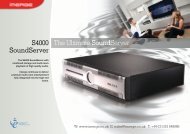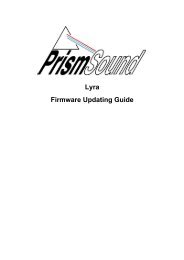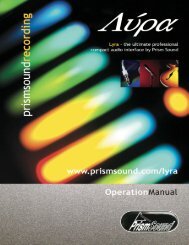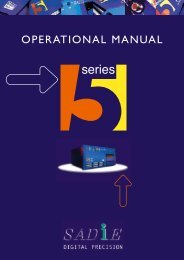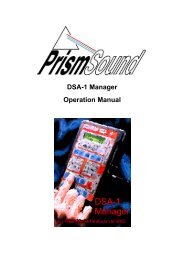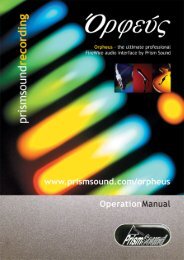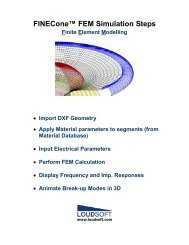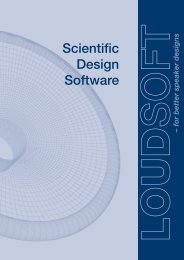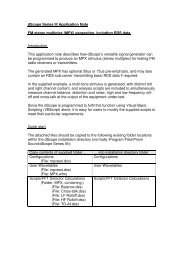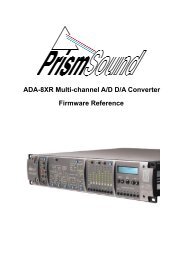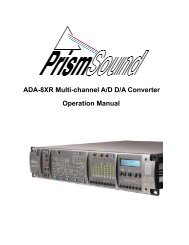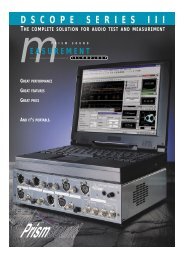ADA-8XR Multi-channel A/D D/A Converter Operation Manual
ADA-8XR Multi-channel A/D D/A Converter Operation Manual
ADA-8XR Multi-channel A/D D/A Converter Operation Manual
Create successful ePaper yourself
Turn your PDF publications into a flip-book with our unique Google optimized e-Paper software.
Prism Sound <strong>ADA</strong>-<strong>8XR</strong> <strong>Multi</strong>-<strong>channel</strong> A/D D/A <strong>Converter</strong> <strong>Operation</strong> <strong>Manual</strong> - Revision 1.00<br />
Note that no wordlength reduction is supported by the <strong>ADA</strong>-<strong>8XR</strong> at the ‘4x’ sample-rates<br />
(176.4kHz and 192kHz). The wordlength is fixed at 24-bits at these rates. It is uncommon to<br />
find ‘4x’ recorders or <strong>channel</strong>s which do not support full 24-bit operation.<br />
7.4 Prism Sound MR-X and DRE encoding processes<br />
Section 7.3 was concerned with limitations in signal quality imposed by restricted audio<br />
wordlengths, and described the dithering and noise-shaping processes used at points of<br />
wordlength reduction in order to make the best use of the available wordlength. Clearly dither<br />
and noise-shaping are irreversible processes: the added noise cannot be removed, the lost<br />
bits cannot be recovered. For this reason it makes sense to maintain the longest possible<br />
wordlength throughout the production chain, and to use dithering or noise shaping as the final<br />
step in reducing the wordlength to that of the chosen delivery medium. This is particularly<br />
true of noise shaping, which can be detrimental to subsequent signal processing.<br />
The problem in maintaining wordlength in the earlier parts of the production chain has often<br />
been the lack of availability of long-wordlength recorders or transmission paths. The<br />
<strong>ADA</strong>-<strong>8XR</strong> incorporates two alternative methods of ‘extending’ the wordlength of a digital<br />
recorder or transmission <strong>channel</strong>, each of which can be used with either a 16-bit or a 20-bit<br />
medium. The first, Prism Sound MR-X, is a ‘word-mapping’ or ‘bit splitting’ system which<br />
allows tracks on a multi-track medium to be sacrificed in order to make up the extra<br />
wordlength. The second, Prism Sound DRE, requires no track sacrifice and so can be used<br />
on stereo media; however, unlike MR-X, DRE does not guarantee to preserve the precise<br />
input data. Both encoding schemes must be decoded in order to reconstitute the audio<br />
signal. The necessary decoders are also included in the <strong>ADA</strong>-<strong>8XR</strong>.<br />
7.4.1 Prism Sound MR-X<br />
Originally featured on the Prism Sound MR-2024T Interface<br />
Adapter for Tascam DA-88, the MR-X encoding system<br />
became a de-facto standard for storing 20-bit and 24-bit audio<br />
on MDMs. When the need to pass CD-targetted material with<br />
extended wordlength to mastering studios was recognised, the<br />
MR-X format provided at that time the only cost-effective<br />
medium which was accepted by the world’s top mastering<br />
© Prism Media Products Limited, 2001-2004 Page 1.31



